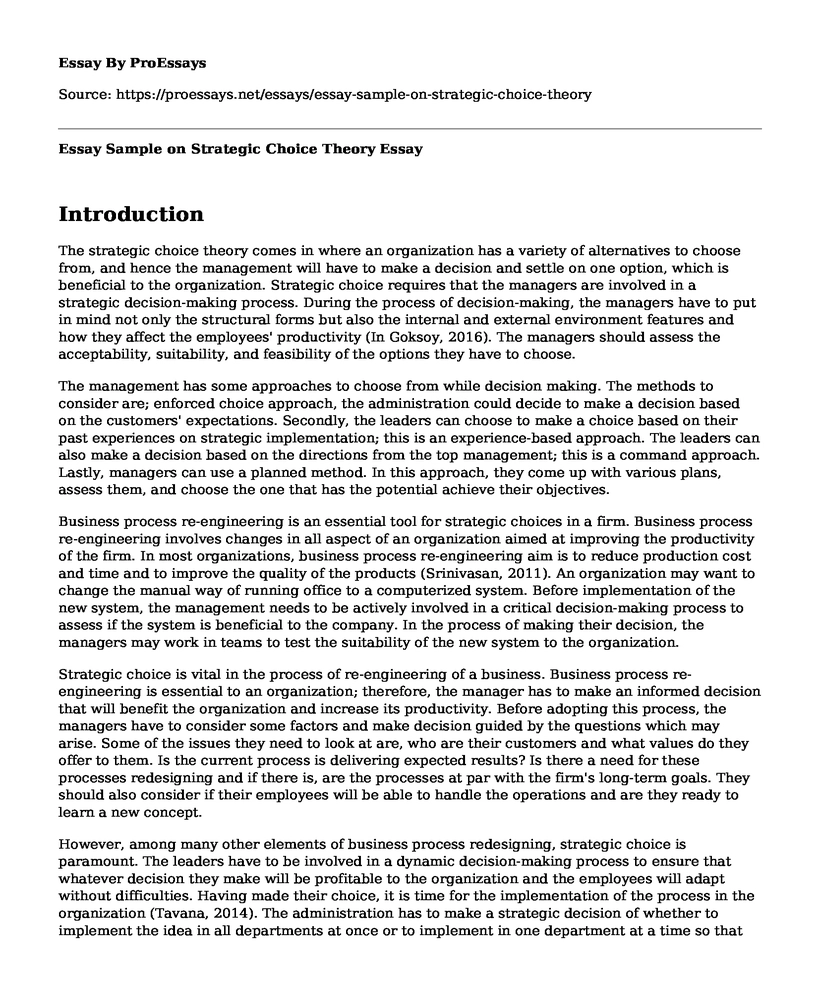Introduction
The strategic choice theory comes in where an organization has a variety of alternatives to choose from, and hence the management will have to make a decision and settle on one option, which is beneficial to the organization. Strategic choice requires that the managers are involved in a strategic decision-making process. During the process of decision-making, the managers have to put in mind not only the structural forms but also the internal and external environment features and how they affect the employees' productivity (In Goksoy, 2016). The managers should assess the acceptability, suitability, and feasibility of the options they have to choose.
The management has some approaches to choose from while decision making. The methods to consider are; enforced choice approach, the administration could decide to make a decision based on the customers' expectations. Secondly, the leaders can choose to make a choice based on their past experiences on strategic implementation; this is an experience-based approach. The leaders can also make a decision based on the directions from the top management; this is a command approach. Lastly, managers can use a planned method. In this approach, they come up with various plans, assess them, and choose the one that has the potential achieve their objectives.
Business process re-engineering is an essential tool for strategic choices in a firm. Business process re-engineering involves changes in all aspect of an organization aimed at improving the productivity of the firm. In most organizations, business process re-engineering aim is to reduce production cost and time and to improve the quality of the products (Srinivasan, 2011). An organization may want to change the manual way of running office to a computerized system. Before implementation of the new system, the management needs to be actively involved in a critical decision-making process to assess if the system is beneficial to the company. In the process of making their decision, the managers may work in teams to test the suitability of the new system to the organization.
Strategic choice is vital in the process of re-engineering of a business. Business process re-engineering is essential to an organization; therefore, the manager has to make an informed decision that will benefit the organization and increase its productivity. Before adopting this process, the managers have to consider some factors and make decision guided by the questions which may arise. Some of the issues they need to look at are, who are their customers and what values do they offer to them. Is the current process is delivering expected results? Is there a need for these processes redesigning and if there is, are the processes at par with the firm's long-term goals. They should also consider if their employees will be able to handle the operations and are they ready to learn a new concept.
However, among many other elements of business process redesigning, strategic choice is paramount. The leaders have to be involved in a dynamic decision-making process to ensure that whatever decision they make will be profitable to the organization and the employees will adapt without difficulties. Having made their choice, it is time for the implementation of the process in the organization (Tavana, 2014). The administration has to make a strategic decision of whether to implement the idea in all departments at once or to implement in one department at a time so that they can observe how the process will work for different departments each at a time.
Conclusion
To sum it up, it is essential that the management should adopt the strategic choice theory while introducing a new concept or idea in their organization (In Kessler, 2013). The strategic choice will help the leaders to have a better understanding of any new business they want to try because they will put more time and effort to understand the idea before deciding on recommending it to the employees. During the decision-making process, the managers should not only take into account the internal factors they should also consider external factors affecting the ideal such as environmental factors.
References
In Goksoy, A. (2016). Organizational change management strategies in modern business. Hershey, Pennsylvania IGI Global.In Kessler, E. H. (2013). Encyclopedia of management theory. Thousand Oaks, Calif: SAGE.
Srinivasan, R. (2011). Business process reengineering. New Delhi: Tata McGraw Hill Education Pte Ltd.
Tavana, M. (2014). Developing business strategies and identifying risk factors in modern organizations. Hershey, PA: Business Science Reference.
Cite this page
Essay Sample on Strategic Choice Theory. (2022, Mar 31). Retrieved from https://proessays.net/essays/essay-sample-on-strategic-choice-theory
If you are the original author of this essay and no longer wish to have it published on the ProEssays website, please click below to request its removal:
- Adding Value in Hairdresser Business Essay
- Risk Taking in Adolescence Article Analysis Paper Example
- Essay on Organizational Culture & Corporate Strategy: ACADIA Pharmaceuticals Case Study
- Essay Example on Success of Restaurant: Uniting Production and Service Delivery
- Essay Sample on Ancient Greek Leadership: Harmonizers, Teachers, & Providers of Resources
- Essay on Mark & Spencer: Strategic & Financial Challenges Under New CEO Roger Holmes
- Applying Nelson Mandela's Leadership Skills to My Leadership - Essay Sample







